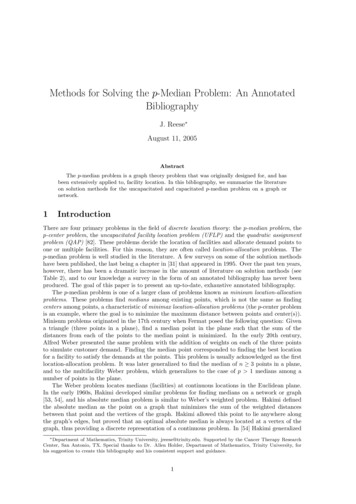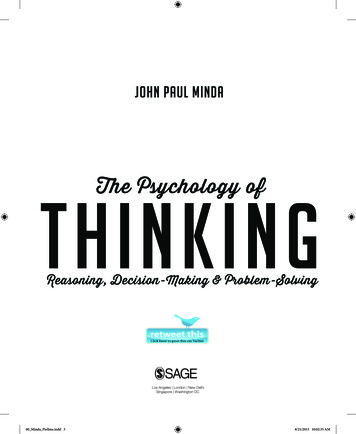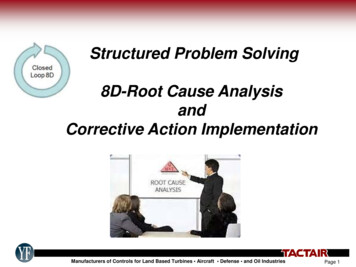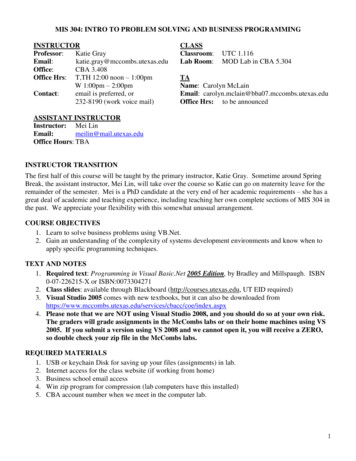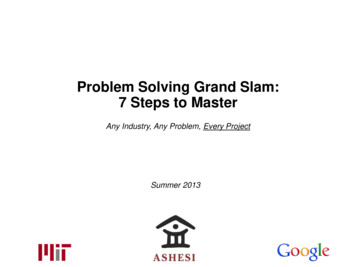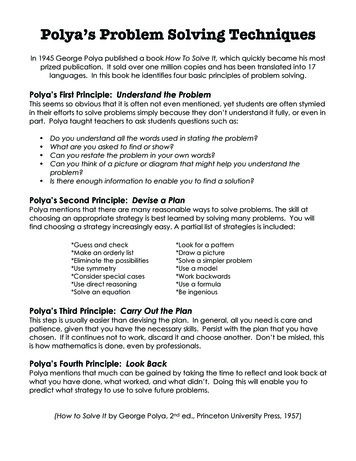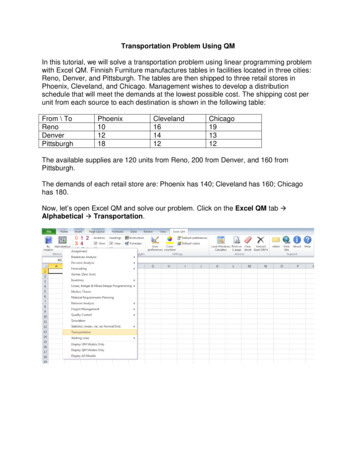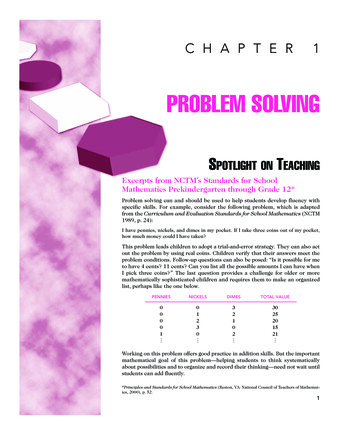
Transcription
ben32947 ch01.qxd11/26/20023:51 PMPage 1C H A P T E R1PROBLEM SOLVINGSPOTLIGHT ON TEACHINGExcerpts from NCTM’s Standards for SchoolMathematics Prekindergarten through Grade 12*Problem solving can and should be used to help students develop fluency withspecific skills. For example, consider the following problem, which is adaptedfrom the Curriculum and Evaluation Standards for School Mathematics (NCTM1989, p. 24):I have pennies, nickels, and dimes in my pocket. If I take three coins out of my pocket,how much money could I have taken?This problem leads children to adopt a trial-and-error strategy. They can also actout the problem by using real coins. Children verify that their answers meet theproblem conditions. Follow-up questions can also be posed: “Is it possible for meto have 4 cents? 11 cents? Can you list all the possible amounts I can have whenI pick three coins?” The last question provides a challenge for older or moremathematically sophisticated children and requires them to make an organizedlist, perhaps like the one below.PENNIESNICKELSDIMESTOTAL VALUE00001M01230M32102M3025201521MWorking on this problem offers good practice in addition skills. But the importantmathematical goal of this problem—helping students to think systematicallyabout possibilities and to organize and record their thinking—need not wait untilstudents can add fluently.*Principles and Standards for School Mathematics (Reston, VA: National Council of Teachers of Mathematics, 2000), p. 52.1
ben32947 ch01.qxd11/26/20023:51 PMPage 22Math Activity 1.1TOWERP U Z Z L E P AT T E R N SPuzzle: One of thethree towers shown here has 10disks of increasing size. What isthe least number of movesneeded to transfer these 10disks from one tower to a different tower if only one disk canbe moved at a time and a diskcannot be placed on top of a smaller one?NO. OFDISKSNO. OFMOVES123451————1. Use a model by drawing three towers on a sheet of paper and placing a quarter, nickel, penny, and dime on one of the towers (or disks can be cut frompaper). Experiment.*2. Solve a simpler problem by using fewer disks. What is the smallest numberof moves needed to transfer 2 disks? Then try 3 disks.*3. Make a table and record the smallest number of moves for 2, 3, and 4 disks.Try to predict the number of moves for 5 disks.*4. Find a pattern in the table and extend the table for up to 10 disks.NO. OFDISKSNO. OFMOVES6789101————5. You may have noticed a pattern in transferring the disks in the first three activities. The sequence of four figures below shows 3 disks being transferredfrom one tower to another. Three moves are needed to go from (a) to (b) because it takes 3 moves to transfer the top 2 disks from one tower to another.Then 1 move is used from (b) to (c) to transfer the third disk, and 3 moremoves are needed from (c) to (d) to place the 2 smaller disks on top of thethird disk.3 moves(a)1 move(b)3 moves(c)(d)Notice how these figures show that the number of moves for transferring 2disks can be used to determine the number of moves for transferring 3 disks.Draw a similar sketch, and explain how the number of moves for transferring 3disks can be used to determine the number of moves for transferring 4 disks.*A star indicates an activity is answered or suggestions are given in the Answer Section.
ben32947 ch01.qxd11/26/20023:51 PMPage 33SECTION 1.1Introduction to Problem SolvingThere is no moresignificant privilege thanto release the creativepower of a child’s mind.Franz F. HohnCourtesy of InternationalBusiness Machines CorporationPROBLEMOPENERProblem solving is thehallmark of mathematicalactivity and a major meansof developing mathematicalknowledge.Standards 2000, p. 116.Alice counted 7 cycle riders and 19 cycle wheels going past her house. Howmany tricycles were there?“Learning to solve problems is the principal reason for studying mathematics.”*This statement by the National Council of Supervisors of Mathematics representsa widespread opinion that problem solving should be the central focus of themathematics curriculum.A problem exists when there is a situation you want to resolve but no solutionis readily apparent. Problem solving is the process by which the unfamiliar situation is resolved. A situation that is a problem to one person may not be a problem to someone else. For example, determining the number of people in 3 carswhen each car contains 5 people may be a problem to some elementary schoolstudents. They might solve this problem by placing chips in boxes or by making adrawing to represent each car and each person (Figure 1.1) and then counting todetermine the total number of people.Figure 1.1You may be surprised to know that some problems in mathematics are unsolved and have resisted the efforts of some of the best mathematicians to solve*National Council of Supervisors of Mathematics, Essential Mathematics for the 21st Century (Minneapolis,MN: Essential Mathematics Task Force, 1988).
ben32947 ch01.qxd411/26/20023:51 PMPage 4CHAPTER 1 Problem Solvingthem. One such problem was discovered by Arthur Hamann, a seventh-grade student. He noticed that every even number could be written as the difference of twoprimes.* For example,2 5 3Doing mathematics involvesdiscoverey. Conjecture—thatis, informed guessing—is amajor pathway to discovery.Teachers and researchersagree that students can learnto make, refine, and testconjectures in elementaryschool.Standards 2000, p. 574 11 76 11 58 13 510 13 3After showing that this was true for all even numbers less than 250, he predictedthat every even number could be written as the difference of two primes. No onehas been able to prove or disprove this statement. When a statement is thought tobe true but remains unproved, it is called a conjecture.Problem solving is the subject of a major portion of research and publishing inmathematics education. Much of this research is founded on the problem-solvingwritings of George Polya, one of the foremost twentieth-century mathematicians.Polya devoted much of his teaching to helping students become better problemsolvers. His book How to Solve It has been translated into 18 languages. In thisbook, he outlines the following four-step process for solving problems.Understanding the Problem Polya suggests that a problem solver needs to become better acquainted with a problem and work toward a clearer understandingof it before progressing toward a solution. Increased understanding can comefrom rereading the statement of the problem, drawing a sketch or diagram toshow connections and relationships, restating the problem in your own words, ormaking a reasonable guess at the solution to help become acquainted with thedetails.Devising a Plan The path from understanding a problem to devising a plan maysometimes be long. Most interesting problems do not have obvious solutions. Experience and practice are the best teachers for devising plans. Throughout thetext you will be introduced to strategies for devising plans to solve problems.Carrying Out the Plan The plan gives a general outline of direction. Write downyour thinking so your steps can be retraced. Is it clear that each step has beendone correctly? Also, it’s all right to be stuck, and if this happens, it is sometimesbetter to put aside the problem and return to it later.Looking Back When a result has been reached, verify or check it by referring tothe original problem. In the process of reaching a solution, other ways of lookingat the problem may become apparent. Quite often after you become familiar witha problem, new or perhaps more novel approaches may occur to you. Also, whilesolving a problem, you may find other interesting questions or variations that areworth exploring.Polya’s problem-solving steps will be used throughout the text. The purpose ofthis section is to help you become familiar with the four-step process and to acquaint you with some of the common strategies for solving problems: making adrawing, guessing and checking, making a table, using a model, and workingbackward. Additional strategies will be introduced throughout the text.*M. R. Frame, “Hamann’s Conjecture,” Arithmetic Teacher 23, no. 1 (January 1976): 34–35.
ben32947 ch01.qxd11/26/20023:51 PMPage 5McGraw-Hillyright 2002 by Thelan/McGraw-Hill. Cop, Grade Six, by MacmilticsmatheMall-HiFrom McGraw.raw-Hill Companies, Incpermission of The McGed byCompanies, Inc. Reprint
ben32947 ch01.qxd611/26/20023:51 PMPage 6CHAPTER 1 Problem SolvingMaking a DrawingOne of the most helpful strategies for understanding a problem and obtainingideas for a solution is to draw sketches and diagrams. Most likely you have heardthe expression “A picture is worth a thousand words.” In the following problem,the drawings will help you to think through the solution.PROBLEMOf the many descriptions ofproblem-solving strategies,some of the best known canbe found in the work ofPolya (1957). Frequentlysited strategies includeusing diagrams, lookingfor patterns, listing allpossibilities, trying specialvalues or cases, workingbackward, guessing andchecking, creating anequivalent problem, andcreating a simpler problem.Standards 2000, p. 53For his wife’s birthday, Mr. Jones is planning a dinner party in a large recreationroom. There will be 22 people, and in order to seat them he needs to borrow cardtables, the size that seats one person on each side. He wants to arrange the tablesin a rectangular shape so that they will look like one large table. What is the smallest number of tables that Mr. Jones needs to borrow?Understanding the Problem The tables must be placed next to each other,edge to edge, so that they form one large rectangular table. Question 1: If two tables are placed end to end, how many people can be seated?One large tableDevising a Plan Drawing pictures of the different arrangements of card tables isa natural approach to solving this problem. There are only a few possibilities. Thetables can be placed in one long row; they can be placed side by side with twoabreast; etc. Question 2: How many people can be seated at five tables if they areplaced end to end in a single row?Carrying Out the Plan The following drawings show two of the five possiblearrangements that will seat 22 people. The X’s show that 22 people can be seatedin each arrangement. The remaining arrangements—3 by 8, 4 by 7, and 5 by 6—require 24, 28, and 30 card tables, respectively. Question 3: What is the smallestnumber of card tables needed?xxxxxxxxxxxxxxxxxxxxxxxxxxxxx10 tablesxxxxxx18 tablesxxxxxxxxx
ben32947 ch01.qxd11/26/20023:51 PMPage 7SECTION 1.1 Introduction to Problem Solving7Looking Back The drawings show that a single row of tables requires the fewesttables because each end table has places for 3 people and each of the remainingtables has places for 2 people. In all the other arrangements, the corner tables seatonly 2 people and the remaining tables seat only 1 person. Therefore, regardlessof the number of people, a single row is the arrangement that uses the smallestnumber of card tables, provided the room is long enough. Question 4: What is thesmallest number of card tables required to seat 38 people?Answers to Questions 1–4 1. 6 2. 12 3. 10 4. There will be 3 people at each end tableand 32 people in between. Therefore, 2 end tables and 16 tables in between will be needed to seat38 people.Guessing and CheckingSometimes it doesn’t pay to guess, as illustrated by the cartoon at the left. However, many problems can be better understood and even solved by trial-and-errorprocedures. As Polya said, “Mathematics in the making consists of guesses.” Ifyour first guess is off, it may lead to a better guess. Even if guessing doesn’t produce the correct answer, you may increase your understanding of the problemand obtain an idea for solving it. The guess-and-check approach is especially appropriate for elementary school children because it puts many problems withintheir reach.PROBLEMHow far is it from town A to town B in this cartoon?Peanuts UFS. Reprinted by Permission.Understanding the Problem There are several bits of information in this problem. Let’s see how Peppermint Patty could have obtained a better understandingof the problem with a diagram. First, let us assume these towns lie in a straightline, so they can be illustrated by points A, B, C, and D, as shown in (a). Next, itis 10 miles farther from A to B than from B to C, so we can move point B closer toABCD(a)390 milesABC(b)D
ben32947 ch01.qxd811/26/20023:51 PMPage 8CHAPTER 1 Problem Solvingpoint C, as in (b). It is also 10 miles farther from B to C than from C to D, so pointC can be moved closer to point D. Finally, the distance from A to D is given as 390miles. Question 1: The problem requires finding what distance?Problem solving is not adistinct topic, but a processthat should permeate thestudy of mathematics andprovide a context in whichconcepts and skills arelearned.Standards 2000, p.182Devising a Plan One method of solving this problem is to make a reasonableguess and then use the result to make a better guess. If the 4 towns were equallyspaced, as in (a), the distance between each town would be 130 miles (390 3).However, the distance from town A to town B is the greatest. So let’s begin with aguess of 150 miles for the distance from A to B. Question 2: In this case, what isthe distance from B to C and C to D?Carrying Out the Plan Using a guess of 150 for the distance from A to B produces a total distance from A to D that is greater than 390. If the distance from Ato B is 145, then the B-to-C distance is 135 and the C-to-D distance is 125. Thesum of these distances is 405, which is still too great. Question 3: What happensif we use a guess of 140 for the distance from A to B?Looking Back One of the reasons for looking back at a problem is to considerdifferent solutions or approaches. For example, you might have noticed that thefirst guess, which produced a distance of 420 miles, was 30 miles too great. Question 4: How can this observation be used to lead quickly to a correct solution ofthe original problem?Answers to Questions 1–4 1. The problem requires finding the distance from A to B. 2. The Bto-C distance is 140, and the C-to-D distance is 130. 3. If the A-to-B distance is 140, then the B-toC distance is 130 and the C-to-D distance is 120. Since the total of these distances is 390, the correctdistance from A to B is 140 miles. 4. If the distance between each of the 3 towns is decreased by 10miles, the incorrect distance of 420 will be decreased to the correct distance of 390. Therefore, the distance between town A and town B is 140 miles.Making a TableA problem can sometimes be solved by listing some of or all the possibilities. Atable is often convenient for organizing such a list.PROBLEMSue and Ann earned the same amount of money, although one worked 6 daysmore than the other. If Sue earned 36 per day and Ann earned 60 per day, howmany days did each work?Understanding the Problem Answer a few simple questions to get a feeling forthe problem. Question 1: How much did Sue earn in 3 days? Did Sue earn asmuch in 3 days as Ann did in 2 days? Who worked more days?Devising a Plan One method of solving this problem is to list each day and eachperson’s total earnings through that day. Question 2: What is the first amount oftotal pay that is the same for Sue and Ann, and how many days did it take each toearn this amount?Carrying Out the Plan The complete table is shown on page 9. There are threeamounts in Sue’s column that equal amounts in Ann’s column. It took Sue 15 days
ben32947 ch01.qxd11/26/20023:51 PMPage 9SECTION 1.1 Introduction to Problem Solving9to earn 540. Question 3: How many days did it take Ann to earn 540, and whatis the difference between the numbers of days they each required?NO. OF DAYSSUE’S PAYANN’S 20780840900Looking Back You may have noticed that every 5 days Sue earns 180 andevery 3 days Ann earns 180. Question 4: How does this observation suggest adifferent way to answer the original question?Answers to Questions 1–4 1. Sue earned 108 in 3 days. Sue did not earn as much in 3 days as Anndid in 2 days. Sue must have worked more days than Ann to have earned the same amount. 2. 180.It took Sue 5 days to earn 180, and it took Ann 3 days to earn 180. 3. It took Ann 9 days to earn 540, and the difference between the numbers of days Sue and Ann worked is 6. 4. When Sue hasworked 10 days and Ann has worked 6 days (a difference of 4 days), each has earned 360; when theyhave worked 15 days and 9 days (a difference of 6 days), respectively, each has earned 540.Using a ModelModels are important aids for visualizing a problem and suggesting a solution. Therecommendations by the Committee on the Undergraduate Program in Mathematics (CUPM) contain frequent references to the use of models for illustratingnumber relationships and geometric properties.*The next problem uses whole numbers 0, 1, 2, 3, . . . and is solved by using amodel. It involves a well-known story about the German mathematician KarlGauss. When Gauss was 10 years old, his schoolmaster gave him the problem ofcomputing the sum of whole numbers from 1 to 100. Within a few moments theyoung Gauss wrote the answer on his slate and passed it to the teacher. Beforeyou read the solution to the following problem, try to find a quick method forcomputing the sum of whole numbers from 1 to 100.PROBLEMFind an easy method for computing the sum of consecutive whole numbers from1 to any given number.*Committee on the Undergraduate Program in Mathematics, Recommendations on the Mathematical Preparation of Teachers (Berkeley, CA: Mathematical Association of America, 1983).
ben32947 ch01.qxd1011/26/20023:52 PMPage 10CHAPTER 1 Problem SolvingUnderstanding the Problem If the last number in the sum is 8, then the sum is1 2 3 4 5 6 7 8. If the last number in the sum is 100, then thesum is 1 2 3 . . . 100. Question 1: What is the sum of whole numbersfrom 1 to 8?Devising a Plan One method of solving this problem is to cut staircases out ofgraph paper. The one shown in (a) is a 1-through-8 staircase: There is 1 square inthe first step, there are 2 squares in the second step, and so forth, to the last step,which has a column of 8 squares. The total number of squares is the sum 1 2 3 4 5 6 7 8. By using two copies of a staircase and placing them together, as in (b), we can obtain a rectangle whose total number of squares can easily be found by multiplying length by width. Question 2: What are the dimensionsof the rectangle in (b), and how many small squares does it contain?Problem solving is not only agoal of learning mathematicsbut also a major means ofdoing so.Standard 2000, p. 521-through-8 staircaseTwo 1-through-8 staircases(a)(b)Carrying Out the Plan Cut out two copies of the 1-through-8 staircase andplace them together to form a rectangle. Since the total number of squares is 8 9, the number of squares in one of these staircases is (8 9)/2 36. So the sumof whole numbers from 1 to 8 is 36. By placing two staircases together to form arectangle, we see that the number of squares in one staircase is just half the number of squares in the rectangle. This geometric approach to the problem suggeststhat the sum of consecutive whole numbers from 1 to any specific number is theproduct of the last number and the next number, divided by 2. Question 3: Whatis the sum of whole numbers from 1 to 100?Looking Back Another approach to computing the sum of whole numbers from1 to 100 is suggested by the following diagram, and it may have been the methodused by Gauss. If the numbers from 1 to 100 are paired as shown, the sum of eachpair of numbers is 101.1 2 3 4 .101101101101101 50 51 . 97 98 99 100
ben32947 ch01.qxd11/26/20023:52 PMPage 11SECTION 1.1 Introduction to Problem Solving11Question 4: How can this sum be used to obtain the sum of whole numbers from1 to 100?Answers to Questions 1–4 1. 36 2. The dimensions are 8 by 9, and there are 8 9 72 smallsquares. 3. Think of combining two 1-through-100 staircases to obtain a rectangle with 100 101squares. The sum of whole numbers from 1 to 100 is 100(101)/2 5050. 4. Since there are 50 pairsof numbers and the sum for each pair is 101, the sum of numbers from 1 to 100 is 50 101 5050.HISTORICALHIGHLIGHTHypatia370–415thenaeus, a Greek writer (ca. 200), in his book Deipnosophistoe mentionsa number of women who were superior mathematicians. However, Hypatiain the fourth century is the first woman in mathematics of whom we have considerable knowledge. Her father, Theon, was a professor of mathematics at theUniversity of Alexandria and was influential in her intellectual development,which eventually surpassed his own. She became a student of Athens at theschool conducted by Plutarch the Younger, and it was there that her fame as amathematician became established. Upon her return to Alexandria, she accepted an invitation to teach mathematics at the university. Her contemporaries wrote about her great genius. Socrates, the historian, wrote that herhome as well as her lecture room was frequented by the most unrelenting scholars of the day. Hypatia was the author of several treatises on mathematics, butonly fragments of her work remain. A portion of her original treatise On the Astronomical Canon of Diophantus was found during the fifteenth century in theVatican library. She also wrote On the Conics of Apollonius. She invented an astrolabe and a planesphere, both devices for studying astronomy, and apparatuses for distilling water and determining the specific gravity of water.*A*L. M. Osen, Women in Mathematics (Cambridge, MA: MIT Press, 1974), pp. 21–32.PROBLEMWorking BackwardA businesswoman went to the bank and sent half of her money to a stockbroker.Other than a 2 parking fee before she entered the bank and a 1 mail fee aftershe left the bank, this was all the money she spent. On the second day she returned to the bank and sent half of her remaining money to the stockbroker. Onceagain, the only other expenses were the 2 parking fee and the 1 mail fee. If shehad 182 left, how much money did she have before the trip to the bank on thefirst day?Understanding the Problem Let’s begin by guessing the original amount ofmoney, say, 800, to get a better feel for the problem. Question 1: If the businesswoman begins the day with 800, how much money will she have at the endof the first day, after paying the mail fee?Devising a Plan Guessing the original amount of money is one possible strategy,but it requires too many computations. Since we know the businesswoman has
ben32947 ch01.qxd1211/26/20023:52 PMPage 12CHAPTER 1 Problem Solving;;;;;;;;;;;;;; 182 at the end of the second day, a more appropriate strategy for solving theproblem is to retrace her steps back through the bank (see the following diagram).First she receives 1 back from the mail fee. Continue to work back through thesecond day in the bank. Question 2: How much money did the businesswomanhave at the beginning of the second day?;;;;;;;;;;;;;;;;;;BANKParkingfee 2The goal of schoolmathematics should be forall students to becomeincreasingly able and willingto engage with and solveproblems.Enter12of moneySendMailfee 1Standards 2000, p.182LeaveCarrying Out the Plan The businesswoman had 368 at the beginning of thesecond day. Continue to work backward through the first day to determine howmuch money she had at the beginning of that day. Question 3: What was thisamount?Looking Back You can now check the solution by beginning with 740, the original amount of money, and going through the expenditures for both days to see if 182 is the remaining amount. The problem can be varied by replacing 182 atthe end of the second day by any amount and working backward to the beginningof the first day. Question 4: For example, if there was 240 at the end of the second day, what was the original amount of money?Answers to Questions 1–4 1. 398 2. The following diagram shows that the businesswoman had 368 at the beginning of the second day.End of day 2 182Beginning of day 2 183Receive 1mail fee 366Receive 1 2 ofmoney sent 368Receive 2parking fee3. The diagram shows that the businesswoman had 740 at the beginning of the first day, so this isthe original amount of money.End of day 1 368 369Receive 1mail fee4. 972Beginning of day 1 738Receive 1 2 ofmoney sent 740Receive 2parking fee
ben32947 ch01.qxd11/26/20023:52 PMPage 13SECTION 1.1 Introduction to Problem Solving13Sometimes the main difficulty in solving a problem is knowing what question is to beanswered.E X E R C I S E S A N D P R O B L E M S 1.1Problems 1 through 20 involve strategies that were presented in this section. Some of these problems are analyzed by Polya’s four-step process. See if you can solvethese problems before answering parts a, b, c, and d.Other strategies may occur to you, and you are encouraged to use the ones you wish. Often a good problem requires several strategies.MAKING A DRAWING (1–4)1. A well is 20 feet deep. A snail at the bottom climbsup 4 feet each day and slips back 2 feet each night.How many days will it take the snail to reach the topof the well?a. Understanding the Problem What is the greatest height the snail reaches during the first 24hours? How far up the well will the snail be at theend of the first 24 hours?b. Devising a Plan One plan that is commonlychosen is to compute 20/2, since it appears thatthe snail gains 2 feet each day. However, 10 daysis not the correct answer. A second plan is tomake a drawing and plot the snail’s dailyprogress. What is the snail’s greatest height during the second day?20151050c. Carrying Out the Plan Trace out the snail’sdaily progress, and mark its position at the end ofeach day. On which day does the snail get out ofthe well?d. Looking Back There is a “surprise ending” atthe top of the well because the snail does not slipback on the ninth day. Make up a new snail problem by changing the numbers so that there willbe a similar surprise ending at the top of the well.2. Five people enter a racquetball tournament in whicheach person must play every other person exactlyonce. Determine the total number of games that willbe played.3. When two pieces of rope are placed end to end, theircombined length is 130 feet. When the two piecesare placed side by side, one is 26 feet longer thanthe other. What are the lengths of the two pieces?4. There are 560 third- and fourth-grade students inKing Elementary School. If there are 80 more thirdgraders than fourth-graders, how many thirdgraders are there in the school?MAKING A TABLE (5–8)5. A bank that has been charging a monthly service feeof 2 for checking accounts plus 15 cents for eachcheck announces that it will change its monthly feeto 3 and that each check will cost 8 cents. Thebank claims the new plan will save the customermoney. How many checks must a customer writeper month before the new plan is cheaper than theold plan?a. Understanding the Problem Try some numbersto get a feel for the problem. Compute the cost of10 checks under the old plan and under the newplan. Which plan is cheaper for a customer whowrites 10 checks per month?
ben32947 ch01.qxd1411/26/20023:52 PMPage 14CHAPTER 1 Problem Solvingb. Devising a Plan One method of solving thisproblem is to make a table showing the cost of 1check, 2 checks, etc., such as that shown below.How much more does the new plan cost than theold plan for 6 checks?CHECKS12345678COST FOROLD PLAN, COST FORNEW PLAN, 2.152.302.452.602.753.083.163.243.323.40c. Carrying Out the Plan Extend the table untilyou reach a point at which the new plan ischeaper than the old plan. How many checksmust be written per month for the new plan to becheaper?d. Looking Back For customers who write 1check per month, the difference in cost betweenthe old plan and the new plan is 93 cents. Whathappens to the difference as the number ofchecks increases? How many checks must a customer write per month before the new plan is 33cents cheaper?6. Sasha and Francisco were selling lemonade for 25cents per half cup and 50 cents per full cup. At theend of the day they had collected 15 and had used37 cups. How many full cups and how many halfcups did they sell?7. Harold wrote to 15 people, and the cost of postagewas 4.08. If it cost 20 cents to mail a postcard and32 cents to mail a letter, how many postcards did hewrite?8. I had some pennies, nickels, dimes, and quarters inmy pocket. When I reached in and pulled out somechange, I had less than 10 coins whose value was 42cents. What are all the possibilities for the coins Ihad in my hand?same digits, and the sum of the digits in eachnumber is 13. Find two two-digit numbers suchthat the sum of the digits is 10 and both numbershave the same digits.b. Devising a Plan Since there are only nine twodigit numbers whose digits have a sum of 10, theproblem can be easily solved by guessing. What isthe difference of your two two-digit numbersfrom part a? If this difference is not 54, it canprovide information about your next guess.c. Carrying Out the Plan Continue to guess andcheck. Which pair of numbers has a differenceof 54?d. Looking Back This problem can be extendedby changing the requirement that the sum of thetwo digits equal 10. Solve the problem for thecase in which the digits have a sum of 12.10. When two numbers are multiplied, their product is759; but when one is subtracted from the other,their difference is 10. What are these two numbers?11. When asked how aperson can measure out 1 gallon ofwater with only a4-gallon containerand a 9-gallon container, a studentused this “picture.”a. Briefly describewhat the student could haveshown by thissketch.b. Use a similarsketch to showhow 6 gallonscan be measured out by using these samecontainers.4-galloncontaine
Devising a Plan The path from understanding a problem to devising a plan may sometimes be long. Most interesting problems do not have obvious solutions. Ex-perience and practice are the best teachers for devising plans. Throughout the text you will be intro

